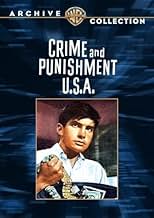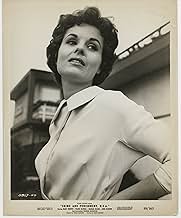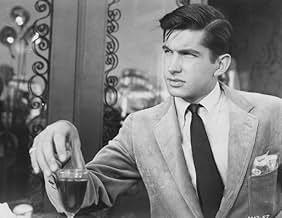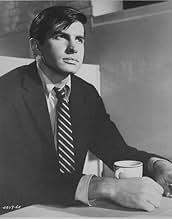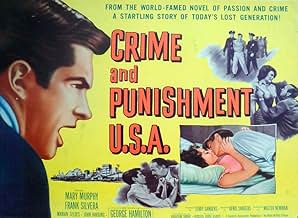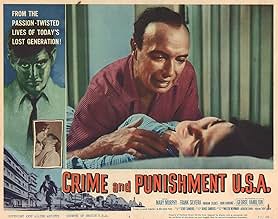Ajouter une intrigue dans votre langueA Californian law student murders a pawnbroker, then matches wits with the detective on the case.A Californian law student murders a pawnbroker, then matches wits with the detective on the case.A Californian law student murders a pawnbroker, then matches wits with the detective on the case.
- Director
- Writers
- Stars
- Nominé pour le prix 1 BAFTA Award
- 2 victoires et 1 nomination au total
Tony Johnson
- Mrs. Cole
- (as Toni Merrill)
Sidney Clute
- Doctor
- (as Sid Clute)
James Hyland
- Man in Coffee Shop
- (as Jim Hyland)
Avis en vedette
This is a very good adaptation of Dostoevsky's novel. The actors all gave solid performances, and the script captures the essence of an investigation into a crime that will depend on not on physical evidence, or finding a witness, but on a psychological campaign by the police detective, as he seeks to get a crack his suspect. As George Hamilton's Robert fences with Frank Silvera's Inspector Porter, he tries to come to terms with his own guilt and fear. In the end, it resolves wonderfully, with Robert coming to terms with his actions and deciding how to live them.
The low budget for the film seems to have been a benefit in this case. The seedy Southern California landscapes give a feel of desperation that makes the initial crime believable, and makes Robert's desire to escape it understandable. And the 'cheapness' fits the small cast, and the film's concentration on a few characters, intensifying the psychological pressure Robert is feeling.
Really well done, and I highly recommend it.
The low budget for the film seems to have been a benefit in this case. The seedy Southern California landscapes give a feel of desperation that makes the initial crime believable, and makes Robert's desire to escape it understandable. And the 'cheapness' fits the small cast, and the film's concentration on a few characters, intensifying the psychological pressure Robert is feeling.
Really well done, and I highly recommend it.
"Crime & Punishment, USA" updates Fyodor Dostoevsky novel to the 20th century and transports it from Saint Petersburg to Los Angeles. It wasn't the first film to do so, with a 1956 French adaptation and, before that, the American "Fear" (1946) is a "Crime and Punishment" picture in all but name; plus, another 1959 reworking also from France, Robert Bresson's "Pickpocket," took even more liberties with the text that it's, nonetheless, clearly inspired by. I'm not opposed to loose reworkings in the transmutation from prose to picture; indeed, "Pickpocket" is my favorite Dostoevsky film. Especially for a poor production such as this American counterpart, updating and transporting a narrative in adaptation makes a lot of economic sense. Moreover, it may lead to some interesting reinterpretations of the source that make it more relatable to modern times. Asking a low-budget 1959 film to adequately transcribe, say, the criticism of Russian nihilism from Dostoevsky's 19th century is a tall order and equally so for a general 1959 audience to understand. This film acknowledges that; plus, at least, it's evident that the filmmakers comprehended Dostoyevsky's story. Cleverly, they replaced the radicalism of Dostoevsky's era with some from their own--the Beat Generation.
Like Dostoevsky's protagonist Raskolnikov, the film's Robert murders a pawnbroker based on his philosophizing about his own supposed superiority (including in an article he penned), thus allowing him to flaunt the law in pursuit of allegedly benefiting humanity at large. Both characters' beliefs are of the sort of atheistic and counter-cultural order mocked by the conservative Dostoevsky. Thus, we see Robert play the bongos and even tap on his coffee cup before that. He doesn't wear turtlenecks and a fedora like a stereotypical beatnik, but I sense he thinks he's hip smoking a pipe instead of cigarettes like any upstanding 1950s American would. He's also unconcerned when the picture's Sonya type, renamed "Sally," admits her sexual promiscuity, but is upset with her prostitution because it's a self-sacrificing act that goes against his hedonistic thinking. A young George Hamilton looks the part, too. And, to top it off, we get a jazzy score.
I also like what is done with the Svidrigaïlov character, renamed "Fred." He's more vital here to Robert's redemption, unintended as it may be, whereas Sonya's "hooker with a heart of gold" was the underlying force behind that of Raskolnikov. Fortunately, Fred isn't the usual movie heavy as his counterpart was in the 1935 American adaptation, either. In the book, I found him to be one of the more amusing characters, and so he is here. I'm less fond of what is done with Sally. She's also something of a beatnik--what with the book of non-traditional spirituality in her room. She even sleeps with Robert right after he confessed the murder to her. She initially suggests that he turn himself in, but as quickly gives up on the idea. As with other adaptations, time is also given to the inspector interrogating the murderer, which is fairly well done here, although the 1935 French version remains probably my favorite handling of this character dynamic.
Unfortunately, the poor production values also lead to this appearing largely as a filmed play, with characters mostly talking in cramped flats. We don't see too much of Robert's Los Angeles, and he only briefly mentions the sort of wandering throughout the city that Raskolnikov did to consume much of the novel's substantial length. We also don't see the murder. And some of the sound effects are poorly done. Nevertheless, it does that one important thing right in updating its source to the Beat Generation. It's far from the best but also far from the worst version of the book I've seen.
Like Dostoevsky's protagonist Raskolnikov, the film's Robert murders a pawnbroker based on his philosophizing about his own supposed superiority (including in an article he penned), thus allowing him to flaunt the law in pursuit of allegedly benefiting humanity at large. Both characters' beliefs are of the sort of atheistic and counter-cultural order mocked by the conservative Dostoevsky. Thus, we see Robert play the bongos and even tap on his coffee cup before that. He doesn't wear turtlenecks and a fedora like a stereotypical beatnik, but I sense he thinks he's hip smoking a pipe instead of cigarettes like any upstanding 1950s American would. He's also unconcerned when the picture's Sonya type, renamed "Sally," admits her sexual promiscuity, but is upset with her prostitution because it's a self-sacrificing act that goes against his hedonistic thinking. A young George Hamilton looks the part, too. And, to top it off, we get a jazzy score.
I also like what is done with the Svidrigaïlov character, renamed "Fred." He's more vital here to Robert's redemption, unintended as it may be, whereas Sonya's "hooker with a heart of gold" was the underlying force behind that of Raskolnikov. Fortunately, Fred isn't the usual movie heavy as his counterpart was in the 1935 American adaptation, either. In the book, I found him to be one of the more amusing characters, and so he is here. I'm less fond of what is done with Sally. She's also something of a beatnik--what with the book of non-traditional spirituality in her room. She even sleeps with Robert right after he confessed the murder to her. She initially suggests that he turn himself in, but as quickly gives up on the idea. As with other adaptations, time is also given to the inspector interrogating the murderer, which is fairly well done here, although the 1935 French version remains probably my favorite handling of this character dynamic.
Unfortunately, the poor production values also lead to this appearing largely as a filmed play, with characters mostly talking in cramped flats. We don't see too much of Robert's Los Angeles, and he only briefly mentions the sort of wandering throughout the city that Raskolnikov did to consume much of the novel's substantial length. We also don't see the murder. And some of the sound effects are poorly done. Nevertheless, it does that one important thing right in updating its source to the Beat Generation. It's far from the best but also far from the worst version of the book I've seen.
Actually more like the previous years' COMPULSION than a modernization of Fyodor Dostoevsky's CRIME AND PUNISHMENT... although that's exactly what it is, by title, and if Frank Silvera's friendly, complimenting homicide detective is reminiscent of the 1970's TV-cop COLUMBO, both are based on the same literary character...
And ironically, George Hamilton became a victim-of-persuasion from both determined constables and here, resembling Anthony Perkins with the combined personalities of either COMPULSION killer... broodingly into Atheist philosophy while acting too good for everyone, in particular the earthy lawman... he's more aimless than guilt-ridden...
The grainy-B&W Los Angeles-set sequences between Hamilton's Robert and the affable yet clinging detective are no different in tone than existential conversations with deep-thinking heart-of-gold-hooker Mary Murphy, his best buddy (Wayne Heffney) or his sister's middle-aged fiance (seeming straight from an Actor's Studio workshop)... yet the overall stagey aspect's so upfront and natural, CRIME feels more intriguing than meandering...
And while never claiming to be a thriller, it's no melodrama either, fitting within a kind of Beatnik's soulless journey that... between the genuine street thug film noirs and the colorful counter-culture neo noirs... exists within the sharpened jazz-soaked cinema of the late 1950's, as unappreciated now as it was back then.
And ironically, George Hamilton became a victim-of-persuasion from both determined constables and here, resembling Anthony Perkins with the combined personalities of either COMPULSION killer... broodingly into Atheist philosophy while acting too good for everyone, in particular the earthy lawman... he's more aimless than guilt-ridden...
The grainy-B&W Los Angeles-set sequences between Hamilton's Robert and the affable yet clinging detective are no different in tone than existential conversations with deep-thinking heart-of-gold-hooker Mary Murphy, his best buddy (Wayne Heffney) or his sister's middle-aged fiance (seeming straight from an Actor's Studio workshop)... yet the overall stagey aspect's so upfront and natural, CRIME feels more intriguing than meandering...
And while never claiming to be a thriller, it's no melodrama either, fitting within a kind of Beatnik's soulless journey that... between the genuine street thug film noirs and the colorful counter-culture neo noirs... exists within the sharpened jazz-soaked cinema of the late 1950's, as unappreciated now as it was back then.
In California, Robert Cole (George Hamilton) collapses in front of the cops. He buries the evidence of his crime, but a dying man may have seen him. He takes the man back home to Sally. He had written an article stating that certain superior people can break the law which comes to the notice of the police. He is brought in for an interview.
This opens on Pacific Ocean Park in Santa Monica. The most fascinating part of this B-crime movie may be the locations. It's great to see the old California with all the oil rigs. It does have a young George Hamilton as the lead. He's fine, but he's never been a great actor. I wanted this to start as a darker noir crime thriller. Robert should leave the man to die on the side of the road. That's the darker start. It's interesting that Robert has his views. Otherwise, the plot drags and I don't really care about him. This is not as compelling as it should be.
This opens on Pacific Ocean Park in Santa Monica. The most fascinating part of this B-crime movie may be the locations. It's great to see the old California with all the oil rigs. It does have a young George Hamilton as the lead. He's fine, but he's never been a great actor. I wanted this to start as a darker noir crime thriller. Robert should leave the man to die on the side of the road. That's the darker start. It's interesting that Robert has his views. Otherwise, the plot drags and I don't really care about him. This is not as compelling as it should be.
A young man murders an old woman for money, then relies on a sense of intellectual superiority to defeat an investigating detective.
A heavyweight subject like Dostoevski would be a challenge for the most experienced filmmaker. For the youthful crew here, however, it proves way too much. For one, Hamilton simply doesn't have the gravitas to bring off a convincing intellectual heavyweight, and that punches a hole right through the film's middle. But he's not the only one. Silvera's cagey detective makes those cat and mouse sessions with Robert (Hamilton) borderline parody. I don't know what director Sanders was telling him, but whatever it was, it didn't work. Ditto Harding's hammy wife killer that produces another regrettable result. Unfortunately, acting here means more than usual since there's so much loaded conversation. Only the two women, Murphy and Seldes, come off aptly.
On the other hand, the filmmakers certainly don't lack imagination. Adapting a bleak 19th- century Russian novel to the sunny climes of LA amounts to an imaginative undertaking, whatever the outcome. However, modifying a dense 1,000-page novel into a 70-minute screenplay would be a challenge for Dostoevski himself. Unfortunately, the effort here is like trying to pack 10 lbs. of weighty story into a 5 lb. leaky screenplay. All in all, I'm glad the Sanders brothers and Hamilton went on to more appropriate projects.
A heavyweight subject like Dostoevski would be a challenge for the most experienced filmmaker. For the youthful crew here, however, it proves way too much. For one, Hamilton simply doesn't have the gravitas to bring off a convincing intellectual heavyweight, and that punches a hole right through the film's middle. But he's not the only one. Silvera's cagey detective makes those cat and mouse sessions with Robert (Hamilton) borderline parody. I don't know what director Sanders was telling him, but whatever it was, it didn't work. Ditto Harding's hammy wife killer that produces another regrettable result. Unfortunately, acting here means more than usual since there's so much loaded conversation. Only the two women, Murphy and Seldes, come off aptly.
On the other hand, the filmmakers certainly don't lack imagination. Adapting a bleak 19th- century Russian novel to the sunny climes of LA amounts to an imaginative undertaking, whatever the outcome. However, modifying a dense 1,000-page novel into a 70-minute screenplay would be a challenge for Dostoevski himself. Unfortunately, the effort here is like trying to pack 10 lbs. of weighty story into a 5 lb. leaky screenplay. All in all, I'm glad the Sanders brothers and Hamilton went on to more appropriate projects.
Le saviez-vous
- AnecdotesThe opening aerial shots are of Pacific Ocean Park in Santa Monica, CA, a popular amusement park in the 1960s that has since closed down.
- ConnexionsReferenced in Hollywood Mouth 3 (2018)
Meilleurs choix
Connectez-vous pour évaluer et surveiller les recommandations personnalisées
Détails
- Durée1 heure 36 minutes
- Couleur
- Mixage
Contribuer à cette page
Suggérer une modification ou ajouter du contenu manquant

Lacune principale
By what name was Crime & Punishment, USA (1959) officially released in India in English?
Répondre
